- Bernard Preston homepage
- Fiber
- How to Get More Fiber
How to get more fiber
Understanding how to get more fiber from our food will probably have a greater effect and make a larger contribution to our wellness than almost any other factor. Along with it comes a vast array of vitamins, minerals and phytonutrients that otherwise we'd be starved of.
That is an assertion that one could easily dispute; health is made up of many parts.
But the fact remains that the scientists are saying that sufficient fiber is paramount in wellness. It helps prevent allergies, cancer and the autoimmune diseases; and much else. Only 5% of those enjoying typical grocery store food are getting enough; and the average American is eating less than half that recommended by the Institute of Medicine[4].
Quick guide
Only those who have suffered severely from abdominal pain, constipation and generalised inflammation in their bodies will truly understand just how great a contribution dietary fiber can make to our lives.
In one sense it's astonishingly easy; but for those enjoying typical grocery store meals all may not be plain sailing. Food manufacturers extract most of the fiber so that we do not need to chew; and everything slides deliciously down the throat like a slice of cheesecake.
How to get more fiber
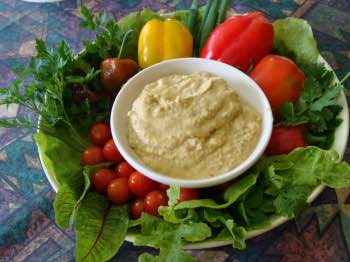 How to get more fiber
How to get more fiber"A cup of cooked oatmeal has 4 grams of fiber and a pear a princely 6g; while a McDonald’s hamburger has only 1 and a soda a big zero."
- Vox
Ballpark fiber figures
Each and everyone of us should go through the little discipline of estimating just how much fiber we are consuming. It will probably take about half an hour; it could literally be a life-changer for you.
There is no need whatsoever to know if you are getting 18.2 grams or 20.3 of fiber; but it is extremely important to ascertain whether it is more or less than 30g. So let's make some rough estimates.
Start by drawing up a Numbers or an Excel file with everything you ate today; with a guesstimate of the number of grams or cups you enjoyed. There is no need to be precise or to go weighing your food.
You will need three columns. You will quickly notice that I eat differently most likely. Don't be put off by that. Since discovering that fiber was the solution to my bellyache I simply had to ring in the changes; or continue to suffer. A heavy rectal bleed lasting two weeks gave me great motivation. I recommend you act before that day comes.
Then go to Professor Google and type in for example "how much fiber is there in 1 banana?" Look for an answer in grams.
Breakfast rich in fiber
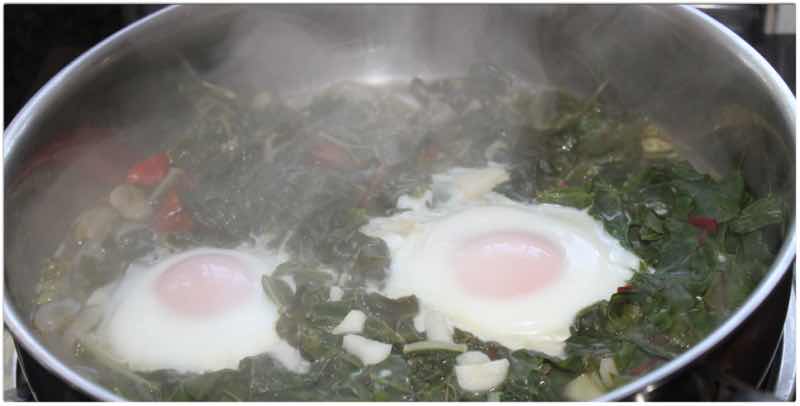 2 grams of fiber in 1/2 cup of spinach; none in the eggs.
2 grams of fiber in 1/2 cup of spinach; none in the eggs.Food
- Blueberries
- Grits
- Wholewheat toast
- Eggs Florentine
- Smoothie
Measure
- 10
- 1 cup
- 1/2 slice
- 1/2 cup spinach
- 1/4 banana
- 1 TBSP flax
- 2 passion-fruit
Grams of fiber
- 0.6g
- 3g
- 2g
- 2g
- 0.5g
- 2g
- 4g
So the total estimated fiber in my breakfast this morning is very roughly about 15 grams.
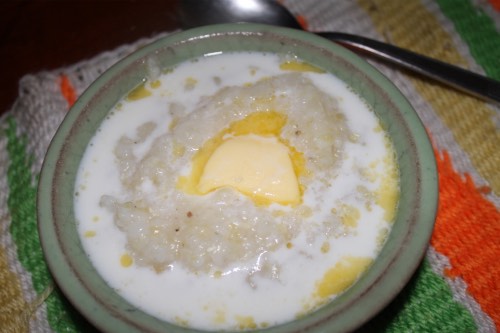 True wholegrain grits
True wholegrain gritsLunch rich in fiber
Food
- WW bread
- Mixed salad
- Hummus
- Avocado
Measure
- 1.5 slices
- Large
- 1 TBSP
- 1/2
Grams of fiber
- 5g
- 6g
- 1g
- 5g
The rough estimate of the fiber in my lunch is about 17 grams.
Dinner rich in fiber
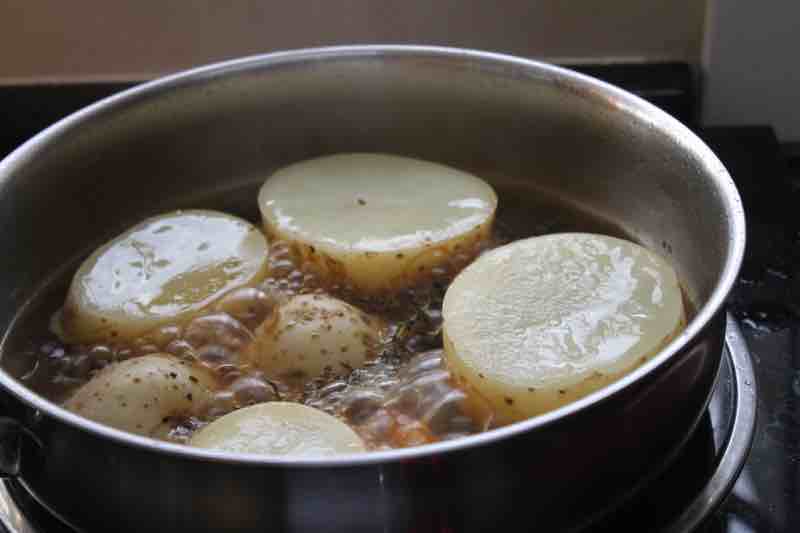 New potatoes with their skins are rich in fiber
New potatoes with their skins are rich in fiberFood
- New potatoes
- Gem squash
- Egg
- Wholewheat toast
- TOTAL FIBER
Measure
- 2 medium size
- 1
- 1
- 0.5 slice
Grams of fiber
- 8g
- 3g
- 0g
- 2g
- 13 GRAMS
Recommended Dietary Allowance of fiber
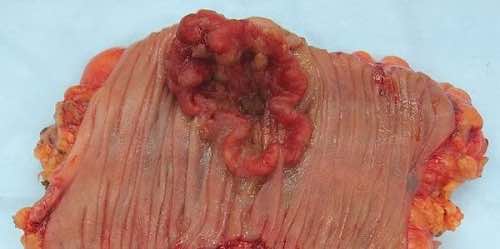 More fiber or colorectal cancer?
More fiber or colorectal cancer?The RDA is about 30 grams of fiber per day; more for men. That's not enough for me; I would still be constipated. Those eating typical grocery store food get less than half the recommended amount.
Typical meals from our Green Home now deliver over 40 grams per day. The stool is a simple, daily two-minute affair; a slippery thin snake that is very easy to pass. Rabbit pellets, thick and painful torpedoes are happily all a matter of the distant past; and bleeding piles too but not forgotten.
"The incidence of early-onset colorectal cancer, defined as a diagnosis at younger than age 50 years has been increasing at an alarming rate; doubled in the large bowel and four times in the anal region."
- JAMA Network Open (May 24, 2024)
- Fresh blood in the stool
- Abdominal pain
- Altered bowel habits
Whole grains and fiber
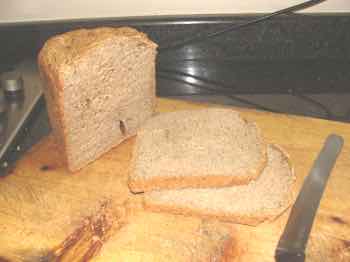 True whole-grain bread
True whole-grain breadWhole grains are very difficult to purchase today. Corn on the cob and brown rice are the exceptions.
Whole grains made up 12 grams of the fiber in my diet today; about one quarter of the total.
There is a Big Fat Lie in the sale of corn and wheat products today; by worldwide law millers may extract 40% of the goodies, the germ and bran and still label their products as "wholegrain."
Don't believe it when you read that your loaf of bread from the grocery store is "wholegrain." At least a third of the bran has been extracted; that is where the lignans too are found that help prevent malignant breast and prostate tumours.
It's no mystery that the prevalence of cancer is rocketing; especially of the colo-rectal region, the prostate and the breast.
New potatoes and fiber
Everything is in the detail when it comes to potatoes. Peeled, from cold-storage and deep fried they are shockingly bad for our health. Lower in fiber, very high GI and generalised inflammation are all the order of the day; they are extremely fattening.
New potatoes, boiled or braised with their skins in olive oil have a large amount of fiber, medium GI and are not fattening; they have a high percentage of resistant starch.
The greens
The greens are personally what really help keep my gut under control. My tum loves it if I enjoy spinach for breakfast and a salad for lunch; and often broccoli or kale for supper. I also like putting them in a condiment to add to our meals.
Fruit
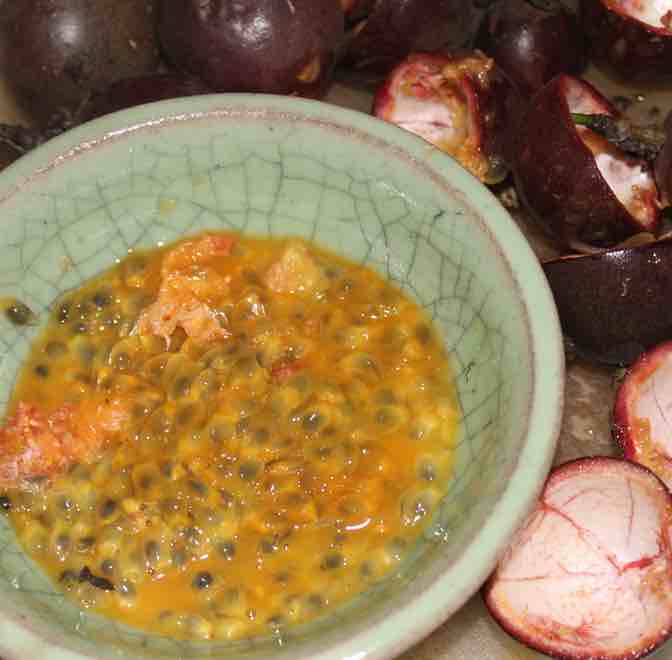 Passion-fruit is rich in fiber
Passion-fruit is rich in fiberFruit makes up an important part of the fiber; the pectin in particular is very soothing for the gut. It contributes up 10 grams if you include the avocado.
In those who have a normal fasting blood glucose incidentally, each 100 grams of fruit daily lowers the risk of developing diabetes by 15%; roughly the weight of an apple[1].
Alas that is not true though for those who are insulin-resistant; even the good carbs like apples and new potatoes have to be limited. In nutritional jargon, keep the glycaemic load to under 50 grams; and less for any who are frankly diabetic.
How to get more fiber
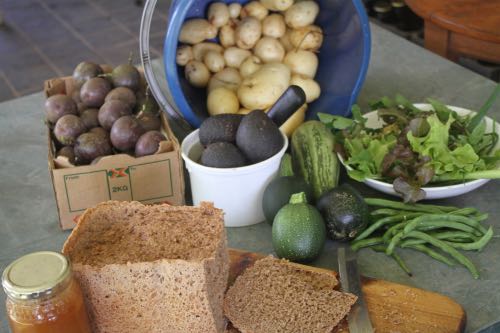 Fiber from the garden
Fiber from the gardenHow to get more fiber to support those friendly bugs in the intestine is today's subject. Gastroenterologists are finding that it plays an extensive role in chronic allergy, inflammatory and autoimmune diseases[2].
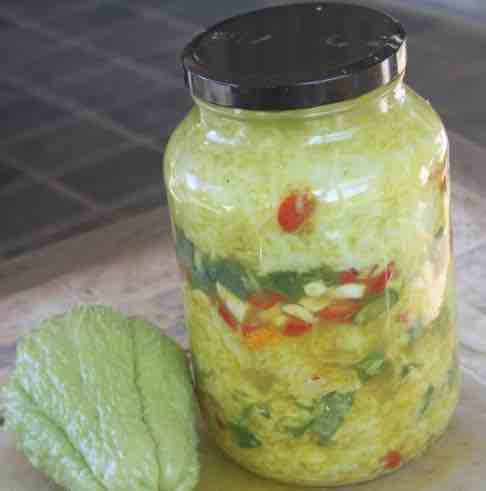
It's quite odd that the chaote squash is highly prized in many countries and equally despised in others. Praised for its surprisingly high protein content, many vitamins and minerals some people object to its slimy feel and lack of flavour. That is because they do not know how to cook with it.
Known as the susu in South Africa it's one of our staples for nearly six months of the year; highly nutritious free food. It grows like a weed in our garden. We particularly love it as a probiotic.
Sauer-susu is a delight. In fact it's a sort of kimchi with garlic, turmeric and hot red peppers; but using chaote instead of cabbage. Both are good. Learn how to make it; less than one hour of labour for a month of a wonderful free probiotic. This is how to get more fiber too.
Microbiome demands undigested carbs
The friendly bacteria, viruses and yeast cells in the happy tum are totally dependent on sufficient dietary fiber. Making probiotics like kefir is a complete waste of time without foods like these[2]; or taking them in supplements.
Sauer-susu has the advantage of built-in fiber; lots of it.
Food is highest in fiber: Legumes
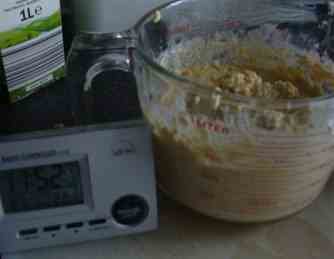 With practice it takes only 4 minutes to make hummus
With practice it takes only 4 minutes to make hummusFirstly may I be abrupt and make a comment about sustainability? There is absolutely no virtue in me telling you that legumes are the best source of fiber if you hate beans.
That's most likely because most of us then think of dried beans or those from a can; I am not fond of them either. Here are a few words of wisdom from the poet Yeats; fresh, green and straight from the garden they are quite different.
And what about chickpeas? Could you learn to make hummus twice a week? It takes about five minutes once you are in the groove. How to get more fiber is not rocket science. But it has to be sustainable; don't even start unless you are willing to continue with it.
Chickpeas are also the richest source of extremely important vitamin; those eating typical grocery store food are typically deficient.
Since I discovered how much hummus helped my tum I have made ten minutes every week for the last twenty years; not for a moment have I regretted it.
One cup of a cooked legume like chickpeas contains about 15 grams of fiber; nearly a half of your daily needs.
Nuts and seeds come a close second. Mill them and put them into smoothies; you could sprinkle a tablespoon on your cereal. You need one of those cheap coffee-grinders.
These foods give that feeling of fullness after eating; they stop us from gorging on too much. Fiber stimulates the production of the "incretin" hormones that signal the pancreas and the hunger centre in the brain.
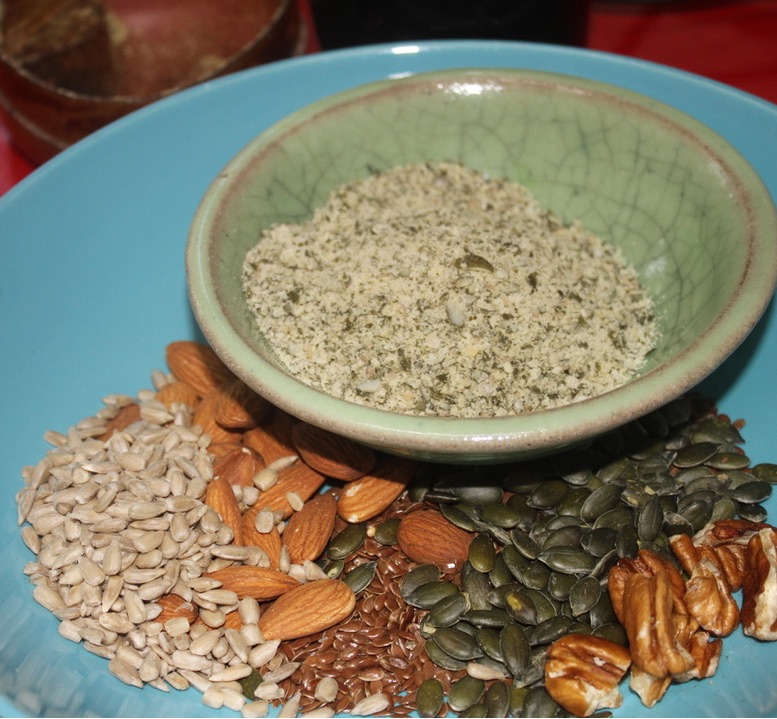
But the fiber in greens is what really helps my tum; spinach, kale and broccoli. Would having Eggs Florentine for breakfast several days a week be sustainable? That too takes about five minutes.
There are no quick fixes in health. Only start with changes that you are prepared to make the effort to continue with; that's why we should despise diets. They simply do not work because they are not sustainable.
Fiber and stem cell transplants
Researchers at the Sloan Kettering Cancer Centre have found that patients with blood disorders such as Multiple Myeloma requiring a stem cell transplant, show significant improvements in overall survival if they maintained diets high in fiber[6].
They recommend an additional avocado, small salad or vegetable soup each day; an increase of just 10 to 20 grams of fiber.
40% of those with a precancerous condition known as "smoldering multiple myeloma" on high fiber diets did not progress to the full-blown disease.
"Researchers found an increased overall survival when there was greater diversity in the gut microbiome, including an abundance of butyrate producers."
- NEJM, February 2020
Butyrate is one of the "short-chain fatty acids" associated with better health; it is produced by the friendly bacteria in the gut of those enjoying a high fiber diet.
Ultraprocessed foods
"Ultraprocessed foods kill us, quite simply, because we can’t help but eat more of them."
- Dr F. Perry Wilson, Yale School of Medicine
The subject is obviously highly complex but ultraprocessed foods are killing us because they are highly delicious and so easy to eat; soft, crunchy and since the fiber has been stripped out they require no chewing[7]. They slide delectably down the throat like a slice of cheesecake; naturally we accept another helping and yet more.
Can you stop at one square of chocolate or a single pancake? Before you know it you have finished the lot.
Now you know how to get more fiber from your food
Is this helpful content?
If you have found the content of this page on how to get more fiber useful, would you recommend it to a few friends who are battling?
Do you know what is "health span?" It's a subject worth investigating. It is the number of years you enjoy without constant pain, disability and medication; or losing your marbles.
- Whole fresh fruit intake and risk of incident diabetes in different glycemic stages
- The Steep Costs of Disrupting Gut-Barrier Harmony
- Gut-love with a gastroenterologist
- Nearly all Americans fail to eat enough of this actual superfood
- Chart of high-fiber foods - Mayo clinic
- High-Fiber Diet Linked to Improved Stem Cell Transplant Outcomes
- The Real Reason Ultraprocessed Foods Are Ruining Our Health
When browsing use right click and "Open Link in New Tab" or you may get a bad gateway signal.
Newsletter
Our newsletter is entitled "create a cyan zone" at your home, preserving both yourself and Mother Earth for future generations; and the family too, of course. We promise not to spam you with daily emails promoting various products. You may get an occasional nudge to buy one of my books.
Here are the back issues.
- Lifestyle and ideal body weight
- What are ultra-processed foods?
- Investing in long-term health
- Diseases from plastic exposure
- Intensive lifestyle management for obesity has limited value
- A world largely devoid of Parkinson's Disease
- The impact of friendly bacteria in the tum on the prevention of cancer
- There's a hole in the bucket
- Everyone is talking about weight loss drugs
- Pull the sweet tooth
- If you suffer from heartburn plant a susu
- Refined maize meal and stunting
- Should agriculture and industry get priority for water and electricity?
- Nature is calling
- Mill your own flour
- Bake your own sourdough bread
- Microplastics from our water
- Alternative types of water storage
- Wear your clothes out
- Comfort foods
- Create a bee-friendly environment
- Go to bed slightly hungry
- Keep bees
- Blue zone folk are religious
- Reduce plastic waste
- Family is important
- What can go in compost?
- Grow broad beans for longevity
- Harvest and store sunshine
- Blue zone exercise
- Harvest and store your rainwater
- Create a cyan zone at your home
Did you find this page interesting? How about forwarding it to a friendly book or food junkie? Better still, a social media tick would help.
- Bernard Preston homepage
- Fiber
- How to Get More Fiber
Address:
56 Groenekloof Rd,
Hilton, KZN
South Africa
Website:
https://www.bernard-preston.com